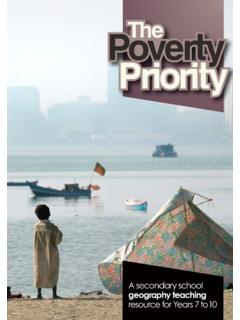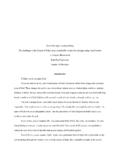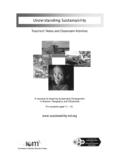Transcription of Useful Geographies - Geocube - The world of …
1 Useful Geographies Geographic skills Geographical skills are fundamental to the way we live, the things we do and the world we live in. We all need geographical skills. Geographical skills are central to Geography s distinctive approach to recognising and exploring patterns, processes and relationships in the world we live in. As a result, it is important that people should acquire the tools and techniques that will allow them to think and act geographically. These skills are: 1) Asking geographic questions, such as why things are where they are and how they got there, 2) Acquiring geographic information, such as locating, observing and systematically recording places, people and environments, using maps, fieldwork, interviews, reference material and library research, 3) Organising geographic information by translating data into visual forms, making maps, graphs, tables, spreadsheets, time lines, oral and written summaries, 4) Analysing geographic information, by probing examining, explaining and synthesising patterns, processes, relationships, connections, trends and sequences 5)
2 Answering geographic questions such as using generalisations, making conclusions, inferences, inductive and deductive reasoning. Generally, geographic skills provide people with the means to ask and answer geographic questions as well as to acquire, organise and analyse spatial information. Our own geography is important therefore we all need geographic skills. Useful Geographies Using maps Geography helps us to learn how to use and make maps. As we are all travelling much more, the skills to read and create maps have become even more important for everyone to have. We all enjoy looking at maps as we are curious about the world we live in.
3 Maps are an important way of communicating, just like books, television, mobile phones and iPods. Reading maps is a geographical skill which we all need to be able to have. It just needs a bit of practice and some interest about the world . Maps are all around us in our busy lives. We use road maps for travelling, planning holidays, plans of shopping centres for finding what we need, street plans of new towns and cities we visit, plans for homes we want to live in and of the weather. A map is a visual representation of an area. Direction, orientation, scale, projection and symbols are some of the important features of maps.
4 It uses symbols to highlight different features and it shows the relationships between different places, regions and topics. Maps are available to us in many different formats, from paper-based to electronic. Digital maps are available on the Internet, via mobile phones and in satellite navigation systems. Cartography is the study and practice of making maps which are representations of the Earth on a flat surface. Maps created by doing surveys of the area. Many large national surveying projects have been carried out by the military. Nowadays satellite information and aerial photography is used to make maps much faster than before and even more accurate.
5 Technologies such as Geographical Information Systems (GIS) are used to greatly improve the usefulness and flexibility of maps. Maps are fun! Once you start to explore them, you can look at places in a lot of detail. Useful Geographies GIS GIS (Geographical Information System) is a potent tool which is used by most public and private organisations around the world to look at a wide range of information about places in the world . We can use GIS to store, retrieve, manipulate and analyse spatial information and related data (attributes). A Geographical Information System (GIS) is a tool that uses computer technologies to help us to easily understand and explain the world around us.
6 A GIS captures, stores, integrates, analyses, manages, and presents data that refers to or is linked to location, Geo-information tools help us to examine, explore and investigate this information. GIS stores the information in a database, analyses it through the GIS software and shares and displays the results, as it can be used to present diverse and complicated information visually. GIS is a very Useful tool for understanding the complex world we live in and in planning and management, for example in hazard and risk prevention with fires, flooding and earthquakes, or for land use decision making. The Internet increases GIS possibilities.
7 There are many questions that are able to be answered by using a GIS, some of these are: Location: What is at a particular place? Condition: Where can we find certain conditions? Trend: Comparing how things have been changing. Routes: The system calculates the optimal path between two points. Patterns: Certain regularities and irregularities can be identified. Models: To simulate what will happen following possible phenomena. Geographers use GIS as a fundamental tool to understand and care for the world we live in. Useful Geographies Risk Calculating risk is something that humans constantly do in the decision making process.
8 Understanding what your potential losses are, and comparing them with the likely revenues is common to us all, whether in deciding which job to take, where to live or in translating a task into actions. Geographers study risk in terms of specific applications. The risks of disease in particular periods of time and at certain locations are investigated In order to better understand the process of disease distribution, spread and prevention. The risk of hazards occurring because of particular weather conditions or prevailing environmental conditions in particular places is evaluated from a geographic perspective since both weather and environment are influenced by location and situation.
9 Examples of this include landslides and avalanches, flooding and other disasters. Risk exposure and risk levels differ from one sector of the population to another. Children have a very different approach to risk than adults. Understanding road safety is therefore an example where understanding of who lives where and uses a road is important for managing risk. Risk assessment is being continuously applied in the insurance sector. Insurances nowadays calculate premiums on risk exposure of particular areas, people and infrastructure. Being interdisciplinary, geographers are able to investigate risk from all angles.
10 Useful Geographies Transport Transport is an established subject area within Geography. It is relevant for geographers because it encompasses the movements of people, goods and materials over space. Understanding the trends and patterns of movement aids decision makers, planners and transport experts in developing strategies that will improve the efficiency of transport systems and to maximise for example, the efficiency of transport infrastructures. Transport geographers use population information as well as socio-economic data from censuses and travel surveys to map the patterns of distribution of people and goods.




